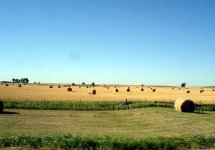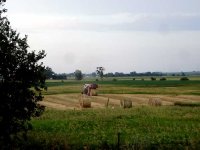You are using an out of date browser. It may not display this or other websites correctly.
You should upgrade or use an alternative browser.
You should upgrade or use an alternative browser.
Here's What I Have Been Doing
- Thread starter SkiWhiz
- Start date
fastforty
Full Member
We just chopped the 14' high silage corn that surrounds our acre. What a relief from the heat & humidity that crashes down on us about the time of evening that it *should* be cooling off. Got a short video around here somewhere- the world's biggest lawnmower. Chops a 16' wide swath of thickly planted 14' high corn at a pretty good clip 

steve in so la
Forum Supporter
- Joined
- May 9, 2006
- Messages
- 7,545
Your pic sure looks better than the old dry desert around here. Steve in so az
Since moving to South Dakota, that's all we see around here is hayfields and cornfields and alphalfa?
I have a question. What is the difference between wheat, hay, and straw? How can I tell which is growing in a field?
I never get tired of looking at the hay rolls or wheels or whatever they call them. I think they are cool.
I have a question. What is the difference between wheat, hay, and straw? How can I tell which is growing in a field?
I never get tired of looking at the hay rolls or wheels or whatever they call them. I think they are cool.
Attachments
SkiWhiz
Elite Member
Carol wrote - Since moving to South Dakota, that's all we see around here is hayfields and cornfields and alphalfa?
I have a question. What is the difference between wheat, hay, and straw? How can I tell which is growing in a field?
I never get tired of looking at the hay rolls or wheels or whatever they call them. I think they are cool.
You city folk are so funny, hay rolls are called round bales. You can tell the difference between the wheat,hay and straw by the the way it looks. Hay is green grass that has been cut (mowed) and then dried. Straw is what is left after mowing oats. Wheat, well wheat is wheat. Steve.
P.S. When I said you city folk are so funny, I mean funny as in not knowing our country folk ways. I didn't mean funny as in weird. Sure looks like some nice open fields you have there in South Dakota. I have never been west of my home state (New York) but some day I would love to.
In your pictures it looks like the land is rolling (small hills) - is that the way it is out there or is the land flat in most areas?
I have a question. What is the difference between wheat, hay, and straw? How can I tell which is growing in a field?
I never get tired of looking at the hay rolls or wheels or whatever they call them. I think they are cool.
You city folk are so funny, hay rolls are called round bales. You can tell the difference between the wheat,hay and straw by the the way it looks. Hay is green grass that has been cut (mowed) and then dried. Straw is what is left after mowing oats. Wheat, well wheat is wheat. Steve.
P.S. When I said you city folk are so funny, I mean funny as in not knowing our country folk ways. I didn't mean funny as in weird. Sure looks like some nice open fields you have there in South Dakota. I have never been west of my home state (New York) but some day I would love to.
In your pictures it looks like the land is rolling (small hills) - is that the way it is out there or is the land flat in most areas?
SkiWhiz
Elite Member
Actually it is even greener than it looks in the picture, my camera isn't the best. Any time you want to get out of the heat (even though it has been hot here, 80's) you are more than welcome to come visit - just bring your "barn" clothes, I am sure I could put you to work lol. Steve.Your pic sure looks better than the old dry desert around here. Steve in so az
hay rolls are called round bales. You can tell the difference between the wheat, hay and straw by the the way it looks. Hay is green grass that has been cut (mowed) and then dried. Straw is what is left after mowing oats. Wheat, well wheat is wheat.
So would you say that the round bales in the pictures are hay? They cut it when it's about thigh high, then let it lay a couple of weeks, and then flip it, then after a couple more weeks they go in and roll it. But the stuff is never green, it grows golden.
Also the bales get loaded onto a train nearby and goes to the west coast to ship overseas. I always assumed it was hay, because that is what they feed the cows too.
I'll see it I can find a closer picture
Ed in KC
Forum Supporter
So would you say that the round bales in the pictures are hay? They cut it when it's about thigh high, then let it lay a couple of weeks, and then flip it, then after a couple more weeks they go in and roll it. But the stuff is never green, it grows golden.
I think your pictures show both straw and hay, the straw being the stuff from the golden fields, the hay looking more golden grayish geen. The gold stuff is probably hard red winter wheat, which actually starts growing in the fall, so you probably weren't there yet when it was green. I'm not a farmer though, so I'm not sure.
SkiWhiz
Elite Member
I am not certain what it is but I would guess it is not hay. I see in your pictures 2 hopper type wagons (called gravity wagons) - they are used to load grain in. And you wouldn't let hay lay a couple of weeks, it would be so dry there wouldn't be any good left to it. Could be wheat,barley,oats,any type of grain. If you get the time stop by and ask the farmer, he would be more than glad to tell you what it is, after all all us farmers are friendly you knowSo would you say that the round bales in the pictures are hay? They cut it when it's about thigh high, then let it lay a couple of weeks, and then flip it, then after a couple more weeks they go in and roll it. But the stuff is never green, it grows golden.
Also the bales get loaded onto a train nearby and goes to the west coast to ship overseas. I always assumed it was hay, because that is what they feed the cows too.
I'll see it I can find a closer picture
 . Steve.
. Steve.Kerry
Senior Member
I live in a farmhouse, and the fields surrounding us used to belong to the house, but the property was parceled out some years back. My neighbor now tends to the fields, and I enjoy sitting out on the porch watching him baling hay every year (better him than me). Its just a grassy pasture, then he cuts it and bales it, and stores it in the barn. This is what feeds his horses during the winter. When he bales its kind of a dried out green color. But he does let it dry for a couple days after cutting before he bales. He uses an older baler - the kind that makes the smaller square bales. Kinda fun to watch - that thing scoops up the grass, forms it into the bale, and even wraps it in wire. He always has two guys on the wagon as he pulls it with the tractor. They stack it on the wagon as the bales come out.
Harley-Dog
Senior Member
Carol wrote - Since moving to South Dakota, that's all we see around here is hayfields and cornfields and alphalfa?
I have a question. What is the difference between wheat, hay, and straw? How can I tell which is growing in a field?
Carol,
Here in Ohio we grow lots of alfalfa hay, clover hay, orchard grass hay, timothy, and combinations of the four--(other types also, but these are the most common). Hay can really be just about any meadow plant that is cut after it gets to a certain height, then sun dried for a couple of days, raked, and finally baled. It becomes barn food (or winter food) for grazing animals (cattle, horses, sheep, goats, etc.).
Straw is the leftover stalks from a grain that has already been harvested (wheat, oats, rye, etc.) When grains like these are harvested, the heads (the top part of the stalk where the grain kernals are located) are all that is taken, leaving the grass-like stalks behind. These stalks are raked and baled and become straw. Straw can be used for animal food, but rarely is, because it has very little nutritional value remaining because the grain head (where most of the nutrients are) has now been separated from it. For the most part, straw is used for animal bedding.
Wheat is just one of many types of grain that farmers grow (barley, oats, rye). Wheat always starts out green and after it reaches it's mature height it begins to die and dry out, turning a golden yellow first and then to a golden brown. That's when its ready to harvest (after its fully dried).
Hope this helps.
Harley-Dog





